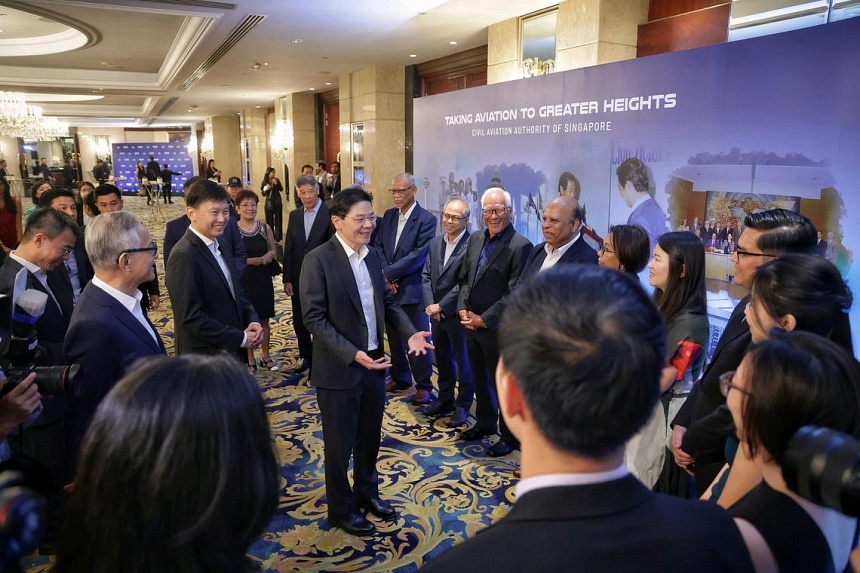Construction of Changi Airport T5 to start in 2025: PM Wong


SINGAPORE — The construction of Changi Airport Terminal 5 (T5) will start in the first half of 2025, said Prime Minister Lawrence Wong.
In the mid-2030s, when the mega terminal is operational, the aim is for Singapore to be linked by air to more than 200 cities, up from almost 150 today.
Speaking at a dinner marking the 40th anniversary of the Civil Aviation Authority of Singapore (CAAS) on Sept 6, he said Singapore must sharpen its competitive edge amid intensifying competition in the air transport sector.
Countries in the region and beyond are making significant investments to expand and improve their airport infrastructure to capture more traffic, noted PM Wong.
"Some have announced plans for mega airports that can handle more than 100 million passengers a year. So they are narrowing the gap with Singapore," he said.
"Many airlines are also rapidly expanding their fleets and networks, including to serve more direct routes. Increasingly, flights that would have passed through Changi may no longer be needed," he added.
"We cannot rest on our laurels," he told the audience of 800 at the Shangri-La Singapore hotel, comprising industry leaders, former and current CAAS staff, and senior government officials.
PM Wong said Singapore's airports are already well-connected, with close to 150 city links today, but the aim is to grow this further.
This will bring more passengers to the Republic and create demand for the broader aviation industry here.
T5 will be able to handle up to 50 million passengers a year on top of Changi Airport's current capacity of 90 million.
It will allow for greater connectivity, transform the passenger experience and create new jobs, he added.
He said the Government is also working closely with international partners to further liberalise Singapore's air services agreements, so that airlines can mount more flights between the city-state and other countries.
In 2024 alone, Singapore signed a new air services agreement with Ukraine, and upgraded existing ones with the Philippines and Saudi Arabia.
In 2019, before Covid-19 struck, the Republic had as many as 175 city links operated by 87 airlines.
This fell to a low of 60 during the depths of the pandemic, before rebounding to more than 140 in March 2023 as Changi Airport and airlines ramped up operations.
In his speech, PM Wong outlined several ways that Singapore can continue to stay ahead of the curve.
The first is to step up innovation, and he cited the work that has been done in the area of airspace management to reduce flight times and fuel consumption, as well as trials of autonomous baggage-handling vehicles being carried out at Changi Airport.
He also cited the establishment of a new International Aviation Lab that will work on more efficient ways to handle aircraft, passengers and baggage.
"This is the first time that an aviation authority, airport operator, airline and aircraft manufacturers are all coming together. It is a good example of how Singapore can convene partners and stakeholders, and serve as a pathfinder for the global aviation industry," he added.
With global air passenger volume projected to double by 2040, PM Wong said Singapore's aviation sector must also grow sustainably and contribute meaningfully to climate action.
While he lauded the adoption of the Sustainable Air Hub Blueprint, which was launched by CAAS in February to tackle aviation emissions, he said the hard work lies in its roll-out.
"We know it is not going to be easy, but we have to give it our best shot."
Finally, he said Singapore must also continue contributing actively to the aviation sector on the international stage, pointing to the $120 million upgrade being made to the Singapore Aviation Academy, which has helped to train more than 160,000 aviation professionals from over 200 countries.
"We are doing this because we want to pay it forward. In our early days, Singapore benefited from such training from other developed countries. Now, it is our turn to do our part," he added.

PM Wong said the pandemic reinforced the importance of the aviation sector to Singapore, even though there were also worries then about the future of Changi Airport and national carrier Singapore Airlines.
"It all feels like a bad dream now... There were moments during (that) period when it seemed like everything was going to fall apart."
But due to the efforts by those in the industry, the sector pulled through and is now back up again, with the aviation workforce exceeding pre-pandemic levels and passenger traffic at Changi Airport in the first half of 2024 almost fully recovered.
Looking ahead, he said the success of Singapore's plans for the aviation sector will benefit all Singaporeans, and there will be a public exhibition in 2025 on the future of the Republic's aviation industry.
"We welcome all Singaporeans to get involved and participate in shaping our Singapore aviation story," he added.
This article was first published in The Straits Times. Permission required for reproduction.